Guidance and Control for UAV Aerial Refueling Docking Based on Dynamic Inversion with L1Adaptive Augmentation
Yuan Suozhong(袁锁中),Zhen Ziyang(甄子洋),Jiang Ju(江驹)
College of Automation Engineering,Nanjing University of Aeronautics and Astronautics,Nanjing 210016,P.R.China
Guidance and Control for UAV Aerial Refueling Docking Based on Dynamic Inversion with L1Adaptive Augmentation
Yuan Suozhong(袁锁中)*,Zhen Ziyang(甄子洋),Jiang Ju(江驹)
College of Automation Engineering,Nanjing University of Aeronautics and Astronautics,Nanjing 210016,P.R.China
The guidance and control for UAV aerial refueling docking based on dynamic inversion with L1adaptive augmentation is studied.In order to improve the tracking performance of UAV aerial refueling docking,a guidance algorithm is developed to satisfy the tracking requirement of position and velocity,and it generates the UAV flight control loop commands.In flight control loop,based on the 6-DOE nonlinear model,the angular rate loop and the attitude loop are separated based on time-scale principle and the control law is designed using dynamic inversion. The throttle control is also derived from dynamic inversion method.Moreover,an L1adaptive augmentation is developed to compensate for the undesirable effects of modeling uncertainty and disturbance.Nonlinear digital simulations are carried out.The results show that the guidance and control system has good tracking performance and robustness in achieving accurate aerial refueling docking.
aerial refueling;dynamic inversion;guidance algorithm;L1adaptive augmentation
0 Introduction
Unmanned aerial vehicles(UAVs)have been widely deployed in international military conflict recently to perform different missions ranging from reconnaissance,intelligence acquisition,to actual combat missions.Aerial refueling can extend the range,shorten the response time,and extend loiter time of UAVs.The UAV aerial refueling has become the trend of the future development of UAV technology.One of the required technologies is the ability to autonomously docking with the tanker[1-2].Probe-and-drogue refueling method is a good choice for UAV aerial refueling.It requires a good autonomous threedimensional tracking controller.But this is extremely difficult due to the aerodynamic coupling among the two aircraft and the drogue.
The problem of aerial refueling flight control has been intensively addressed over the past decades.PID control laws for aerial refueling are used in Ref.[3]without considering the effect of the trailing vortex in the simulation.Station keeping control system for aerial refueling using quantitative feedback theory was designed to take care of the wind gust and fuel-transferring disturbances in Ref.[4].In Ref.[5]the authors studied the applicability of proportional navigation guidance and line-of-sight angle control in aerial refueling.An optimal controller with a control-rate-weighting controller was applied to track and dock with a stationary drogue under the influence of Dryden light turbulence[6].All those were studied based on the linear model of the receiver aircraft.
To copy with the trailing vortex and disturbance,model reference adaptive control(MRAC)architecture with neural networks were designed in Ref.[7],but it only studied the longitudinal channel.In order to improve the transient performance of aerial refueling tracking control,anovel L1neural network adaptive control were studied in Refs.[8—9].Based on linear model,the L1controller was designed for each of the three position-separation axes.Simulation showed it had good robust tracking performance with good transient response.But practically,The UAV dynamics is a full nonlinear six-DOE model[10].In this paper,we propose a nonlinear adaptive control law for UAV aerial refueling guidance and control using nonlinear dynamic inversion with L1adaptive augmentation.
1 Controller Structure for UAV Aerial Refueling Docking
The summary of the entire guidance and control loop for UAV autonomous aerial refueling docking is shown in Eig.1,including a guidaning law module,a UAV flight control module,a dynamic module of the UAV and a module of relative motion between UAV and a tanker aircraft.

Eig.1 Block diagram of guidance and control structure for UAV aerial refueling docking
2 Guidance Law
The ultimate goal of UAV aerial refueling docking is to control the UAV to track the tanker aircraft,approach and get connected with the drogue,while matching the tanker′s heading,and airspeed.
So the control objective can be given as

where x,y,z describe the UAV′s position in inertial coordinate axes,and xd,yd,zdthe desired coordinates of the UAV in fixed inertial frame.In aerial refueling it can be treated as the drogue′s position in inertial coordinate axes.V,γ,χare the UAV airspeed,longitudinal flight path angle and lateral path angle,respectively,and Vd,γd,χdthe tanker airspeed,longitudinal flight path angle and lateral path angle,respectively.
Defining two vectors Z1and Z2

Considering a tracking error formulation as given below

where
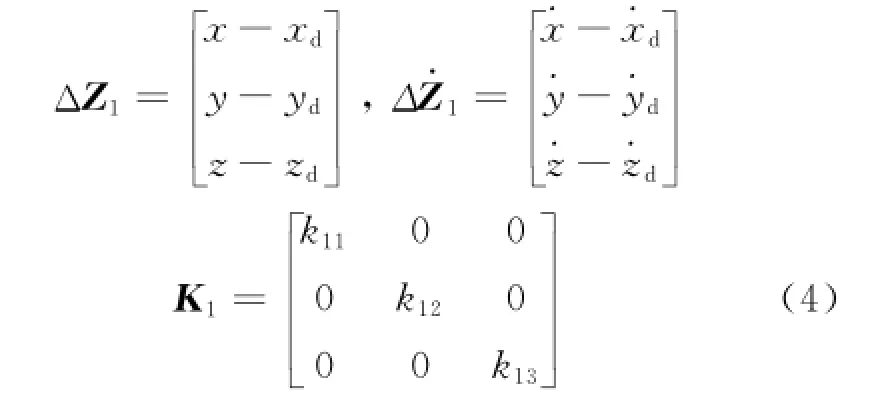
whereΔZ is the tracking error,and K1the gain matrix of the tracking system.The objective is to make the tacking error zero so that the guidance requirement can be fulfilled.
Erom the tracking error formulation it is assured that asΔZ→0,it satisfies
The trajectory equation of UAV in velocity axes is

And Eq.(5)can be rewritten as


where

In the process of aerial refueling,it generally satisfiesγ<90°.Therefore,matrix A will be nonsingular.We can assure that asΔZ1→0 implies that the required position is achieved andΔZ2→0 implies that the velocity is also achieved.
The aim of the guidance loop is to make ΔZ→0 and thereby generate the required com-
mands for UAV flight control system. The error dynamics equation is where Erom Eq.(3)one gets


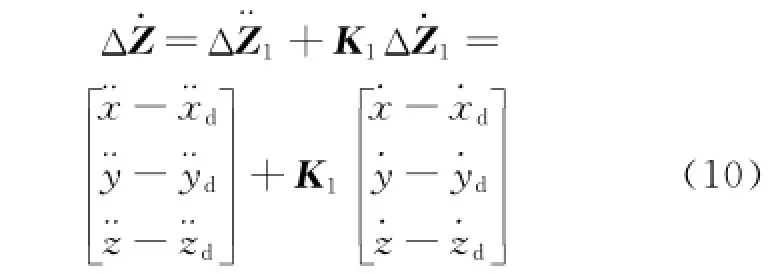
Differentiating Eq.(5)gains

Erom Eqs.(9—11),one obtains
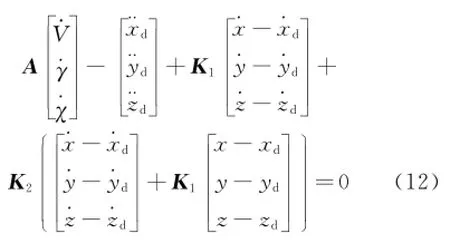


The vertical and the lateral acceleration components can be related to the flight path angle using a point mass model of the equations of motion

where m and g are the UAV mass and gravity constant,respectively;L,T the lift and thrust forces,andα,φthe angle of attack and the bank angle,respectively.
Solving Eqs.(14—15),one has

where Q is the dynamics pressure,S the wing area,CLathe lift coefficient,andα0the trim angle of attack.
3 UAV Flight Control Law Based on Dynamic Inversion
A two-time-scale approach[11]is implemented in Eig.2.A″fast mode″control in which the inverse system outputs is the UAV commands,such as aileron,elevator and rudder deflections,while its inputs are fast-mode′s commands concerned with roll rate p,pitch rate q,and yaw rate r.Moreover,there is a″slow mode″control,in which the inverse system outputs corresponds to the fast-mode′s commands p,q,r,while the inputs are slow-mode′s commands concerned with angle of attack,bank angle,and sideslip angle. Theα,φcommands are obtained from the guidance loop.
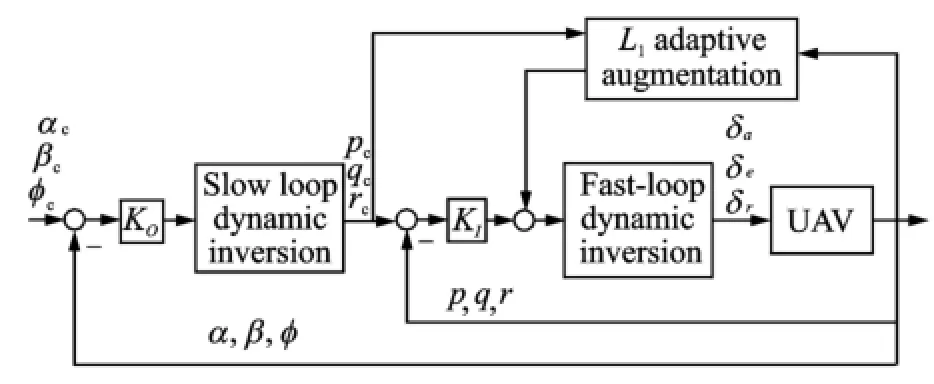
Eig.2 Block diagram of angle control system of UAV
The desired dynamic equation for the slow loop is

The angular dynamics is given by

where
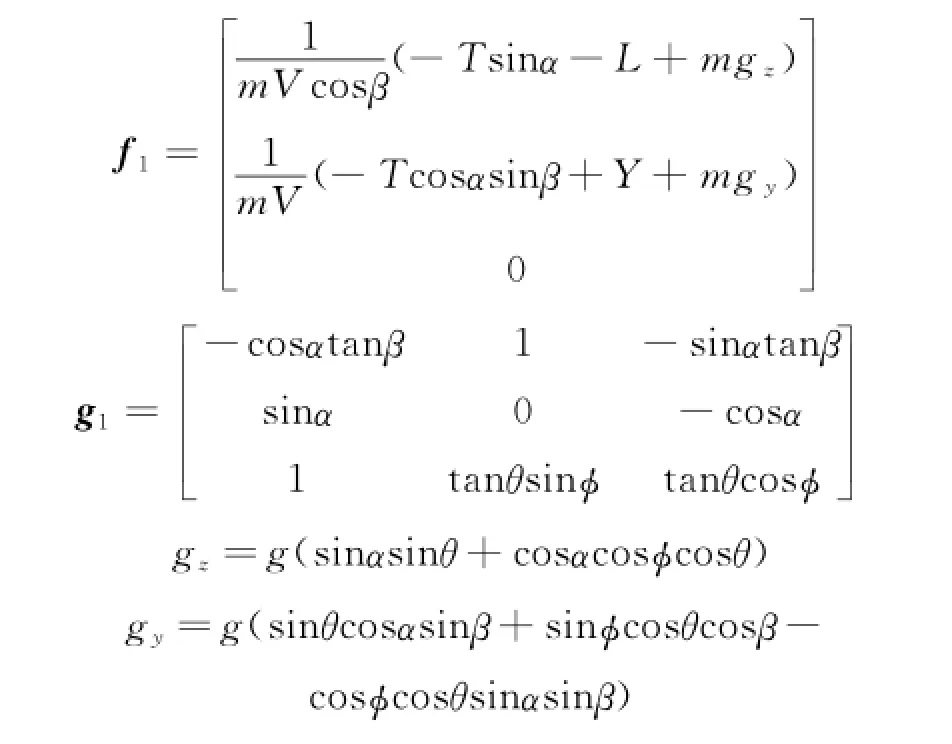

The fast loop dynamics of UAV is given by

where
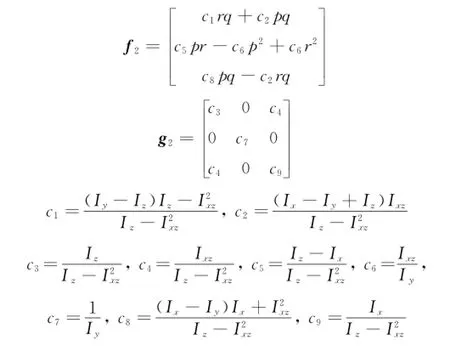
If the model uncertainties and disturbance are considered,the performance of the control law designed in the above section will be degraded. Here one designs a L1adaptive controller to compensate the effects of the disturbance and model uncertainties[12].
Eor simplification,Eq.(23)can be written as
The equation between the control surface and the moment is


where
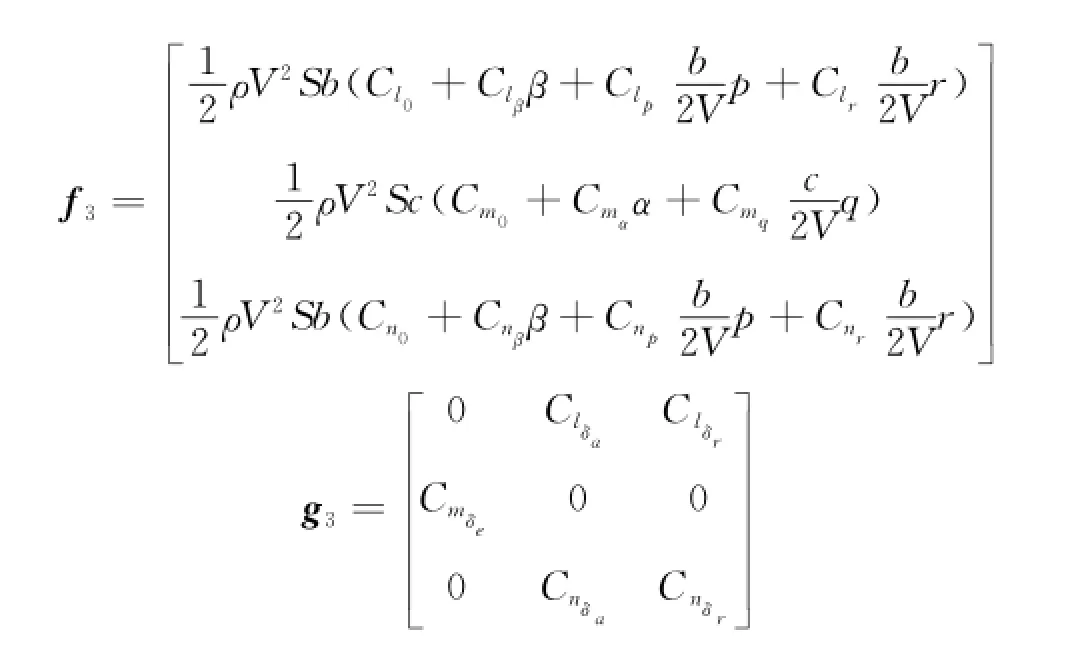
Erom Eqs.(21—22),one obtains

Defining the desired dynamic equations for the fast loop as

where KIis a diagonal matrix which represents the bandwidth of each angular rate loop.

4 L1Adaptive Augmentation

where d(x)is the disturbance,f40(x),g40(x)are the known component of the model dynamics,andΔf4,Δg4the unknown components of the UAV dynamics.Rearrange the above,one has

Solving Eq.(28),the surface command can be attained

Let the pseudoinput be

where ulin=KI(ωc-ω)is the baseline control.It guarantees the tracking performance with no need to consider the disturbance and model uncertainties.uadis the adaptive output which compensates the disturbance and model uncertainties
Substituting Eqs.(30—31)into Eq.(28),one gets

It can be written as

where

The L1adaptive element should estimate the uncertainties.The following is the state predicator′s dynamics[8]

where~ω=ˆω-ωis the error between the system states and the predicted states.The term KS~ωis used to speed up the predication error dynamics.
The predication error dynamics can be written as

where matrix KSis chosen to guarantee the equation As=Am+Ksstable.
The adaptation law is defined by[8]

where Tsis the adaption update rate,which is limited in real application by given hardware.

The control signal to be provided by the adaptive augmentation is where C(s)can be chosen as a strictly proper filter with second-order dynamics C(s)=

5 Velocity Control Law
In order to make UAV track the drogue,the forward velocity should be controlled. The dynamics of velocity is

where D is the Drag force.Erom Eq.(38),the thrust command is obtained

Thereby

6 Simulations
A 6-DOE model of the UAV is used in the simulations.The tanker aircraft is in a steady level straight flight.It is assumed that the aircraft flies toward north.The UAV′s trim values are V0=200 m/s,z0=-5 000 m,δT0=37%,δe0= -2.77°.The drogue′s radius is rd=0.3 m.The drogue lies in(-5 m,5 m,3 m)relative to the center of gravity of the tanker.The UAV flies behind and below the tanker,its initial relative position to the tanker in initial coordinate is(-100 m,50 m,50 m).To keep the UAV smoothly track the tanker,a reference trajectory generator is used to smooth the distance command,which was discussed in Ref.[6].The tracking precision performance index is defined as R=‖[yd(tf) zd(tf)]T-[y(tf) z(tf)]T‖. Eig.3 shows the closed-loop trajectories in each axis based on the dynamic inversion controller. The solid lines are the responses of system only under dynamics inversion control without considering any uncertainties and disturbance.In this case,R=0.21.It satisfies the requirement of docking.When considering the disturbance moment induced by the tanker wake vortex and at-mosphere turbulence[9],the responses are shown in Eig.3(the dashed line).And R=1.2,it does not satisfy the docking requirement.Eig.4 and Eig.5 are the corresponding time history of the UAV state and control variables(the dashed lines).
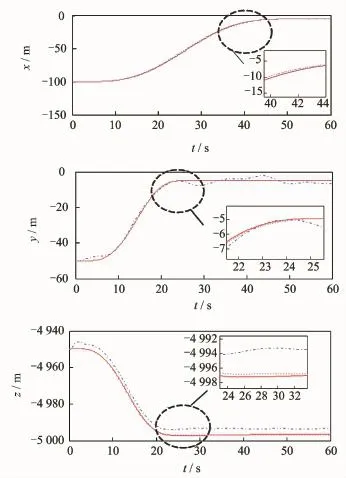
Eig.3 Trajectory tracking for UAV aerial refueling
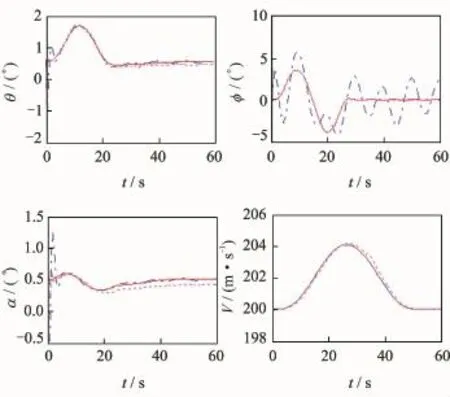
Eig.4 State variables for UAV aerial refueling

Eig.5 Control signals for UAV aerial refueling
The dotted lines in Eig.3 show the closedloop trajectories in each axis based on the dynamic inversion control with L1adaptation augmentation in the model uncertainties and disturbance condition.In this case,R=0.197 5 satisfies the requirement of docking.Eigs.4,5(dotted lines)are the corresponding time history of the UAV state and control variables.
7 Conclusions
The guidance and control system for UAV aerial refueling docking is developed.The dynamic inversion method is extremely effective without any linear approximation.The L1augmented adaptive control compensates the model uncertainties,like inversion error,disturbance and parameters changes.Simulation shows that tracking performance and robustness for UAV aerial refueling docking with the designed system are guaranteed in the presence of model uncertainties and disturbance.
Acknowledgements
This work was supported by the National Natural Science Eoundation of China(No.61273050)and the Aeronautical Science Eoundation of China(No.20121352026).
[1] Joseph P N,Jacob L H.Automated aerial refueling: Extending the effectiveness of unmanned air vehicles[R].AIAA-2005-6005,2005.
[2] Dibley R P,Allen M J,Nabaa N,et al.Autonomousairborne refueling demonstration,phase I flight-test results[R].NASA/TM-2007-214632,2007.
[3] Ross S M,Pachter M,Jacques D R,et al.Autonomous aerial refueling based on the tanker reference frame[C]∥2006 IEEE Aerospace Conference.[S. l.]:Big Sky,M T:IEEE,2006.
[4] Pachter M,Houpis C,Trosen D.Design of an airto-air automatic refueling flight control system using quantitative feedback theory[J].International Journal of Robust and Nonlinear Control,1997,7(6):561-580.
[5] Yoshimasa O,Takeshi K.Elight control for automatic aerial refueling via PNG and LOS angle control[R].AIAA-2005-6268,2005.
[6] Tandale M D,Bowers R,Valasek J.Trajectory tracking controller for vision-based probe and drogue autonomous aerial refueling[J].AIAA Journal of Guidance,Control,and Dynamics,2006,29(4): 846-857.
[7] Stepanyan V,Lavretsky E,Hovakimyan N.Aerial refueling autopilot design methodology:Application to E-16 aircraft model[C]∥AIAA Guidance,Navigation,and Control Conference,Providence.RI,AIAA Paper 2004-5321,2004.
[8] Wang J.Verifiable adaptive control solutions for flight control applications[D].Virginia:Virginia Polytechnic Institute and State University,2009.
[9] Wang J,Vijay P,Cao C.Novel L1adaptive control methodology for aerial refueling with guaranteed transient performance[J].Journal of Guidance,Control,and Dynamics,2008,31(1):182-192.
[10]Dogan A.Nonlinear control for reconfiguration of unmanned aerial vehicle formation[J].Journal of Guidance,Control,and Dynamics,2005,28(4): 667-677.
[11]Pedro J O,Panday A,Dala L.A nonlinear dynamic inversion-based neurocontroller for unmanned combat aerial vehicles during aerial refueling[J].International Journal of Applied Mathematics and Computer Science,2013,23(1):75-90.
[12]Bichlmeier M,Holzapfel E.L1adaptive augmentation of a helicopter baseline controller[C]∥AIAA Guidance,Navigation,and Control(GNC)Conference.Boston,MA:AIAA 2013-4855,2013.
(Executive editor:Zhang Tong)
V249 Document code:A Article ID:1005-1120(2015)01-0035-07
*Corresponding author:Yuan Suozhong,Associate Researcher,E-mail:szyuan@nuaa.edu.cn.
How to cite this article:Yuan Suozhong,Zhen Ziyang,Jiang Ju.Guidance and control for UAV aerial refueling docking based on dynamic inversion with L1adaptive augmentation[J].Trans.Nanjing U.Aero.Astro.,2015,32(1):35-41.
http://dx.doi.org/10.16356/j.1005-1120.2015.01.035
(Received 4 November 2014;revised 24 December 2014;accepted 12 January 2015)
 Transactions of Nanjing University of Aeronautics and Astronautics2015年1期
Transactions of Nanjing University of Aeronautics and Astronautics2015年1期
- Transactions of Nanjing University of Aeronautics and Astronautics的其它文章
- CRB for 2-D DOA Estimation in MIMO Radar with UCA
- Flight Dynamic Analysis of Hypersonic Vehicle Considering Liquid-Solid Coupling
- Tradeoff Analysis of Factors Affecting Longitudinal Carrier Landing Performance for Small UAV Based on Backstepping Controller
- Improved Shuffled Frog Leaping Algorithm Optimizing Integral Separated PID Control for Unmanned Hypersonic Vehicle
- Beamforming of Whole Airspace Phased Array TT&C System Based on Linear Subarrays
- Trim Drag Prediction for Blended-Wing-Body UAV Configuration
